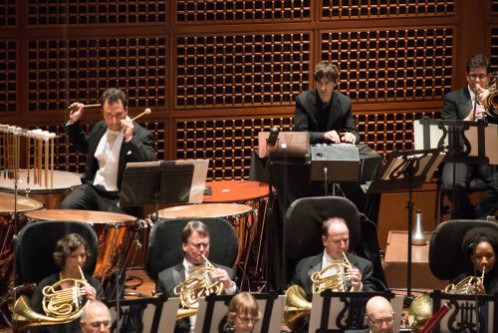 United States Beethoven, Mason Bates: Alexander Barantschik (violin), San Francisco Symphony, Michael Tilson Thomas (conductor), Davies Symphony Hall, San Francisco. 9.1.2014 (HS)
United States Beethoven, Mason Bates: Alexander Barantschik (violin), San Francisco Symphony, Michael Tilson Thomas (conductor), Davies Symphony Hall, San Francisco. 9.1.2014 (HS)

Beethoven: Romance in G Major, Op. 40
Romance in F Major, Op. 50
Mason Bates: The B-Sides
Beethoven: Symphony No. 7 in A Major
Mason Bates has emerged as a wholly original voice in today’s classical music scene. There might be no better evidence of that than hearing his music a second time and realizing it’s even better than you thought.
That was my experience Thursday afternoon in San Francisco Symphony’s second go-round with the composers’s The B-Sides, a quick tour of musical textures, melodies, harmonies and gestures, commissioned by the orchestra. I grinned as one deft touch after another rocketed past. When I first heard it in 2009, I thought it lacked depth. This time, wow.
Tilson Thomas had approached Bates with the thought of emulating the exploration of musical textures and sonorities in Schönberg’s Five Pieces for Orchestra, but with the 21st century’s more accessible musical terms. Bates says he liked the idea of “dropping in” for a few minutes each on sound worlds that he could create with a few musical strokes, enhanced with the electronic sonorities he was exploring in his new music.
As Bates put it in the program notes, “I had often imagined a suite of concise, off-kilter symphonic pieces that would incorporate the grooves and theatrics of electronica in a highly focused manner. So, like the forgotten bands from the flip side of an old piece of vinyl, The B-Sides offers brief landings on a variety of peculiar planets, unified by a focus on fluorescent orchestral sonorities and the morphing rhythms of electronica.”
Bates is no self-conscious classical composer slumming with pop music, or for that matter a pop musician dallying with classical forms. He seems at home in both worlds. The resulting music melds them, well, harmoniously. He stations himself with the percussion session during performances, employing an Apple laptop and an electronic drum pad. To my ears, these contributions from the computerized equipment fold into the texture of the symphony orchestra with greater complexity and as much ease as the ondes martinots in Messiaen’s opera Saint François d’Assise.
Electronica enhances the oddly offbeat rhythmic pulse and delicate percussiveness of the opening piece, “Broom of the System,” in which a percussionist actually wields a straw broom. That, along with sandpaper blocks, provides the tick-tock underlying melodic wisps wafting in and out against thumping pizzicatos in the strings. The second, all-acoustic, “Aerosol Melody (Hanalei),” somehow turns the whole orchestra into a sort of sighing, drowsy electronic soundscape.
The longest, “Gemini in the Solar Wind,” comes next, sampling communications between spacewalking astronauts and NASA as the orchestra blooms with rich, floating blobs of sound, eventually morphing into John Williams-like fanfares. Bates aims to use these spoken words like percussion in the texture, reminiscent of Steve Reich’s Different Trains, which used snippets of train conductors and concentration camp-bound Jews for profound musical and emotional results. Bates achieves a colorful and arresting, but more prosaic, movie score effect.
Jazz beats and gentle riffs pick up the pace in “Temescal Noir,” a colorful (and electronica-free) portrayal of an Oakland, California neighborhood. The finale, “Warehouse Medicine,” blends pounding techno beats and musical gestures into brassy climaxes. At the end of its 22 minutes, this easily accessible but sophisticated music drew a well-deserved standing ovation, even from the gray-haired Thursday afternoon crowd.
This work was being recorded live for an upcoming release in the orchestra’s own CD series, along with two other Bates works to be performed this year. It’s not exactly clear why music director Michael Tilson Thomas elected to surround Bates’ music in these three concerts with pieces by Beethoven. This time Bates affected the impression made by the 19th-century composer more than Beethoven did on Bates’ music.
The pumped-up rhythms and extra resonances in The B-Sides, for example, seemed to spur Tilson Thomas into a particularly exuberant approach to Beethoven’s Symphony No. 7, which occupied the second half of the program. It is Beethoven’s most dance-y symphony anyway. Tilson Thomas just went for it, articulating tempos with extra emphasis. Miraculously, this did not make for a heavy-handed performance. In fact, the inner voices emerged clearly—even a brief sixteenth-note French horn flourish that imitates a similar gesture heard repeatedly in the strings. This usually gets lost in the texture as the finish approaches, but it came through nicely. It was a rousing performance, channeling in its way a 21st-century visceral approach to rhythm without losing the structure and definition of 19th-century music.
For openers, concertmaster Alexander Barantschik was featured in a pair of lovely Beethoven Romances (Op. 40 in G and Op. 50 in F), both lovingly and delicately executed by both soloist and orchestra.
Harvey Steiman